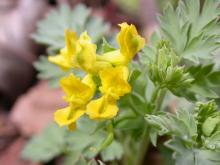Wildflowers, Grasses and Other Nonwoody Plants
Media

Species Types
Scientific Name
Impatiens capensis
Description
Many Missouri children learn about this orange-flowered native plant by playing with the juicy green seedpods, which, when ripe, "explode" upon the slightest touch. This is jewelweed's mechanism for seed dispersal, and it's the reason for the name "touch-me-not."
Media

Species Types
Scientific Name
Ludwigia peploides
Description
Water primrose is a common shoreline plant with bright yellow flowers and long, trailing stems. It grows in dense mats in the shallow areas of ponds, lakes, and streams.
Media

Species Types
Scientific Name
Impatiens pallida
Description
Our two Missouri jewelweeds occur in the same habitats, often side by side, and even botanists can’t tell them apart without the flowers. Pale touch-me-not is the one with the lemon-yellow flowers!
Media

Species Types
Scientific Name
Stylophorum diphyllum
Description
The showy, bright yellow flowers of celandine poppy really stand out in the shady woods and valleys where this plant grows. You should consider this species when you are planting a shade garden!
Media

Species Types
Scientific Name
Corydalis flavula
Description
The smooth, finely divided, fernlike foliage of pale corydalis is similar to that of the related wildflower Dutchman’s breeches. But in pale corydalis, the small yellow flowers appear tubelike and lipped.
Media

Species Types
Scientific Name
Melilotus albus and M. officinale
Description
These two species of sweet clover are present all over America. Although they have been planted for forage, as bee plants, and as nitrogen-fixers, white and yellow sweet clover are now classified as invasive for their weediness and the problems they pose for natural habitats.
Media

Species Types
Scientific Name
Ranunculus fascicularis
Description
There are nearly 20 species in the genus Ranunculus in Missouri. Identify early buttercup by its early blooming time, its distinctively shaped, usually hairy leaves, and its preference for open woods, glades, or prairies.
Media

Species Types
Scientific Name
Solidago spp. (23 species in Missouri)
Description
There are 23 species of goldenrods in Missouri. They can be hard to identify to species, but as a group, the goldenrods are common and nearly unmistakable.
Media

Species Types
Scientific Name
Senna marilandica (formerly Cassia marilandica)
Description
The flowers of southern wild senna don’t look much like typical pea-family flowers, but its leaves and bean pods show the family resemblance. Look for it in moist situations, mostly south of the Missouri River.
Media

Species Types
Scientific Name
Dioscorea oppositifolia (sometimes called D. batatas)
Description
Similar to kudzu, Chinese yam is an aggressive vine that overtakes nearly everything within reach that stands still long enough! Learn more about this invasive plant — and please don’t plant it!
See Also
About Wildflowers, Grasses and Other Nonwoody Plants in Missouri
A very simple way of thinking about the green world is to divide the vascular plants into two groups: woody and nonwoody (or herbaceous). But this is an artificial division; many plant families include some species that are woody and some that are not. The diversity of nonwoody vascular plants is staggering! Think of all the ferns, grasses, sedges, lilies, peas, sunflowers, nightshades, milkweeds, mustards, mints, and mallows — weeds and wildflowers — and many more!





















